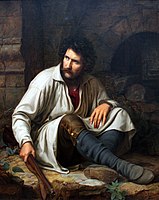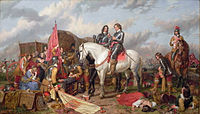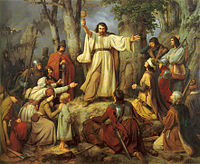Alte Nationalgalerie
 Front façade of the Alte Nationalgalerie | |
 Interactive fullscreen map | |
| Established | 1876 |
|---|---|
| Location | Museum Island, Berlin |
| Coordinates | 52°31′15″N 13°23′53″E / 52.52083°N 13.39806°E |
| Type | Art museum |
| Public transit access | U: Museumsinsel ( |
| Website | Alte Nationalgalerie |
| Part of | Museumsinsel (Museum Island), Berlin |
| Criteria | Cultural: ii, iv |
| Reference | 896 |
| Inscription | 1999 (23rd Session) |
| Area | 8.6 ha (21 acres) |
| Buffer zone | 22.5 ha (56 acres) |
The Alte Nationalgalerie (lit. Old National Gallery) is a
History
Founding
The first impetus to founding a national gallery came in 1815. The idea gained momentum during the 1830s, but without an actual building. In 1841 the first real plans were created. These plans never made it out of the planning stages, but finally in 1861 the
Friedrich August Stüler began working on a design for the building in 1863, based on a sketch by King Frederick William IV of Prussia.[4] Two years and two failed plans later, his third proposal was finally accepted. Stüler died before planning was completed and Carl Busse handled the remaining details in 1865. In 1866, by order of the king and his cabinet, the Kommission für den Bau der Nationalgalerie (Commission for the construction of the national gallery) was created. Ground was broken in 1867 under the supervision of Heinrich Strack. In 1872 the structure was completed and interior work began. The opening took place on 22 March 1876, in the presence of the Kaiser.
Because of the building's modern construction using brick and iron, it was widely believed to be fireproof. The exterior and outer staircase were constructed of Triassic sandstone from Nebra. At the opening the collection was still relatively small. Next to Wagener's collection, originally, was a display of cartoons by Peter von Cornelius that had been bequeathed to the Prussian government. The initial objective of the gallery was to collect contemporary, primarily Prussian art, as Berlin did not then have any repository of modern art.
In 1874 Max Jordan became the first director of the National Gallery. In 1896 he was succeeded by Hugo von Tschudi, who acquired Impressionist works, risking conflict with the Kaiser because this ended the collection's focus on German art. The German National Gallery thus became the most important museum for modern French Art at the turn of the century.[5]
20th century
In 1909,
In 1933, the new Nazi authorities dismissed Justi, who was followed by Eberhard Hanfstaengl. He remained until 1937, when he too was dismissed. His successor, Paul Ortwin Rave, remained until 1950, although because of World War II the building was closed during much of that time. It was heavily damaged in Allied air raids. It was partly reopened in 1949, but reconstruction continued until 1969. Between 1998 and 2001, the museum was renovated thoroughly by German architect HG Merz. Some extra halls were added on the uppermost floor and now contain the Romantic works. The three-year, $62 million renovation of the Alte Nationalgalerie was part of a refurbishment of Museum Island and the energetic effort by government and private institutions to re-establish Berlin as Germany's political and cultural heart.[6]
Architecture
The Alte Nationalgalerie, together with the Altes Museum, the Neues Museum, the Bode Museum, the Pergamon Museum, the Berlin Cathedral and the Lustgarten, make up the Museum Island complex in Berlin. It is situated in the middle of the island, between the rails of the Berlin Stadtbahn and Bode Street on the eastern banks.
It is connected to the Pergamon Museum to the north, and to the Neues Museum, the Altes Museum, and the Berlin Cathedral to the south. The building was designed by
Collection
The collection contains works of the
The Alte Nationalgalerie houses one of the largest collections of 19th-century sculptures and paintings in Germany.[8] In addition, it belongs to the Berlin National Gallery, which in turn is part of the Staatliche Museen zu Berlin. It is the original building of the National Gallery, whose holdings are now housed in several additional buildings.
In October 2021 the Alte Nationalgalerie restituted the Camille Pissarro painting, "A Square in La Roche-Guyon" (1867) to the heirs of Armand Dorville, a French Jewish art collector whose family was persecuted by the Nazis and whose paintings had been sold at a 1942 auction in Nice that was overseen by the Commissariat Général aux Questions Juives. The museum then purchased the Pissarro back.[9]
Gallery
-
Fjord at Holmestrand, Johan Christian Dahl, 1843
-
Liszt at the Piano, Josef Danhauser, 1819
-
The Robber, Theodor Hildebrandt, 1829
-
The Warrior and his Child, Theodor Hildebrandt, 1832
-
Chess Game, Johann Erdmann Hummel, 1819
-
Cromwell in Battle of Naseby, Charles Landseer, 1851
-
Return of the Palikar, Eduard Magnus, 1836
-
Adolph von Menzel, 1852
-
Eisenwalzwerk (The Iron Rolling Mill (Modern Cyclopes)),Adolph von Menzel, 1875
-
Portrait of the Advocate Ernst Lau, Carl Steffeck, 1865
-
Telemachus' Return, Eberhard von Wächter, 1804
-
In the Troops' Quarters outside Paris, Anton von Werner, 1894
See also
- List of art museums
- List of museums in Berlin
- List of museums in Germany
- List of national galleries
- List of tourist attractions in Berlin
- Neue Nationalgalerie
References
- ^ Nationalgalerie & Kolonnaden Archived 12 July 2020 at the Wayback Machine (in German) Landesdenkmalamt Berlin
- ^ "Alte Nationalgalerie". Staatliche Museen zu Berlin. Retrieved 21 February 2023.
- ^ "Museumsinsel (Museum Island), Berlin". UNESCO World Heritage Centre. United Nations Educational Scientific and Cultural Organization. Retrieved 30 July 2022.
- ^ ISBN 978-3-406-52675-6.
- ^ Philipp Demandt: "Schule des Sehens". Die Nationalgalerie und die Moderne, in: Angelika Wesenberg (Hg.), Impressionismus – Expressionismus. Kunstwende, Berlin 2015, pp 13–19.
- ISSN 0362-4331. Retrieved 21 February 2023.
- ISBN 978-3-406-52675-6.
- ^ Alte Nationalgalerie: About, ARTINFO, 2008, retrieved 24 July 2008
- ^ "Berlin museum restitutes—and then buys back—Nazi-looted Pissarro painting". The Art Newspaper – International art news and events. 18 October 2021. Archived from the original on 18 October 2021. Retrieved 6 November 2021.
Further reading
- Maaz, Bernhard; Holan, Gisela; Kilger, Andres; Staatliche Museen zu Berlin (2001). Die Alte Nationalgalerie Geschichte, Bau und Umbau (in German). Berlin: G & H. OCLC 248016716.
- Schuster, Peter-Klaus; Alte Nationalgalerie (2003). Die Alte Nationalgalerie (in German). Berlin: SMB-DuMont. OCLC 54475200.
- Beloubek-Hammer, Anita; Staatliche Museen Preussischer Kulturbesitz. Kupferstichkabinett; Städtisches Kunstmuseum Bonn (2010). Gefühl ist Privatsache : Verismus und Neue Sachlichkeit : Aquarelle, Zeichnungen und Graphik aus dem Berliner Kupferstichkabinett mit Leihgaben (in German). Berlin: SMB Kupferstichkabinett, Staatliche Museen zu Berlin. OCLC 613308928.
- Savoy, Bénédicte; Sissis, Philippa (2013). Die Berliner Museumsinsel Impressionen internationaler Besucher (1830 - 1990) ; eine Anthologie (in German). Köln: Böhlau. OCLC 823229428.
External links
- Official website (in German and English)
- Online collections database (in German)
- 360° Panorama at the Alte Nationalgalerie
- Some paintings from museum collection
- "Alte Nationalgalerie".















